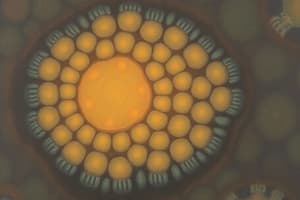Podcast
Questions and Answers
What is the main function of the Golgi Apparatus in a cell?
What is the main function of the Golgi Apparatus in a cell?
Processing and preparing proteins and lipids for transport
Describe the role of lysosomes in a cell.
Describe the role of lysosomes in a cell.
Digesting waste products, damaged organelles, and pathogens
What is the function of centrosomes during cell division?
What is the function of centrosomes during cell division?
Organizing the microtubules of the cytoskeleton
Explain the process of cellular respiration in cells.
Explain the process of cellular respiration in cells.
What is the key function of the nucleus in a cell?
What is the key function of the nucleus in a cell?
Differentiate between animal cells and plant cells based on a specific organelle.
Differentiate between animal cells and plant cells based on a specific organelle.
What is the function of the cell membrane?
What is the function of the cell membrane?
What is the role of the nucleus in a cell?
What is the role of the nucleus in a cell?
How do mitochondria produce energy in a cell?
How do mitochondria produce energy in a cell?
What is the function of ribosomes in protein synthesis?
What is the function of ribosomes in protein synthesis?
Describe the function of the endoplasmic reticulum (ER) in a cell.
Describe the function of the endoplasmic reticulum (ER) in a cell.
What is the purpose of cytoplasm in a cell?
What is the purpose of cytoplasm in a cell?
Flashcards are hidden until you start studying
Study Notes
Unraveling the Building Blocks of Life: Understanding the Fundamental Unit of Life
The fundamental unit of life, often referred to as the cell, is a complex, organized structure that carries out the essential functions necessary for living organisms. A cell is the smallest unit capable of independent existence, and it serves as the building block for all living things on Earth.
Cell Structure
A cell is surrounded by a protective barrier called the cell membrane, which regulates what enters and exits the cell. Inside the cell, an aqueous solution known as the cytoplasm fills the space. The cytoplasm contains various organelles, which are specialized subunits that perform specific functions. Some important organelles include:
- Nucleus: The control center of the cell, containing the cell's DNA and regulating the expression of genes.
- Mitochondria: These double-membrane-bound structures produce energy through cellular respiration, converting nutrients into adenosine triphosphate (ATP).
- Ribosomes: Structures that synthesize proteins from amino acids using messenger RNA (mRNA) as a template. Ribosomes are classified as either free or bound to the endoplasmic reticulum.
- Endoplasmic Reticulum (ER): An extensive network of membrane-bound structures responsible for protein synthesis, lipid production, and the transport of proteins and lipids between organelles.
- Golgi Apparatus: A membrane-bound structure where proteins and lipids synthesized by the endoplasmic reticulum are processed and prepared for transport to the cell membrane or other destinations within the cell.
- Lysosomes: Membrane-bound organelles containing enzymes that break down waste products, damaged organelles, and invading pathogens.
- Centrosomes: Structures involved in organizing the microtubules of the cytoskeleton during cell division.
Cell Processes
Cells carry out a wide range of processes to maintain homeostasis and fulfill their functions. Some essential processes include:
- Cellular respiration: The process by which cells produce energy through the breakdown of nutrients, such as glucose.
- Photosynthesis: The process by which plants, algae, and some bacteria convert light energy into chemical energy, using water and carbon dioxide to produce glucose and oxygen.
- Protein synthesis: The process by which cells produce proteins using mRNA as a template and ribosomes as the sites for translation.
- DNA replication: The process by which cells make exact copies of their DNA prior to cell division.
- Cell division: The process by which cells produce new cells through mitosis or meiosis.
Cell Organelles and Their Functions
Cells contain various organelles specialized to carry out specific functions. Some key examples are:
- Nucleus: Stores and replicates the genetic information of the cell and regulates gene expression.
- Mitochondria: Produce energy through cellular respiration.
- Ribosomes: Synthesize proteins using mRNA as a template.
- Endoplasmic Reticulum: Synthesizes proteins and lipids, and processes and transports proteins and lipids.
- Golgi Apparatus: Processes and prepares proteins and lipids for transport.
- Lysosomes: Digest waste products, damaged organelles, and pathogens.
- Centrosomes: Organize the microtubules of the cytoskeleton during cell division.
Cell Types
Cells can be classified into several types based on their structure, function, and location in a multicellular organism. Some examples include:
- Animal cells: Cells found in animals, characterized by their lack of a cell wall, the presence of organelles such as mitochondria and endoplasmic reticulum, and their enclosed nucleus.
- Plant cells: Cells found in plants, characterized by their cell wall made of cellulose, the presence of chloroplasts for photosynthesis, and their lack of a centrosome.
- Prokaryotic cells: Simple, unicellular organisms, characterized by their lack of a nucleus and membrane-bound organelles. Prokaryotes include bacteria and archaea.
- Eukaryotic cells: Complex, unicellular or multicellular organisms, characterized by their membrane-bound nucleus and organelles. Eukaryotic cells include animal, plant, fungal, and protist cells.
Understanding the fundamental unit of life, the cell, is essential for comprehending the complex and interconnected processes that sustain life on Earth. By exploring the structure, processes, organelles, and functions of cells, we gain a deeper appreciation for the intricate system that makes up living organisms.
Studying That Suits You
Use AI to generate personalized quizzes and flashcards to suit your learning preferences.




